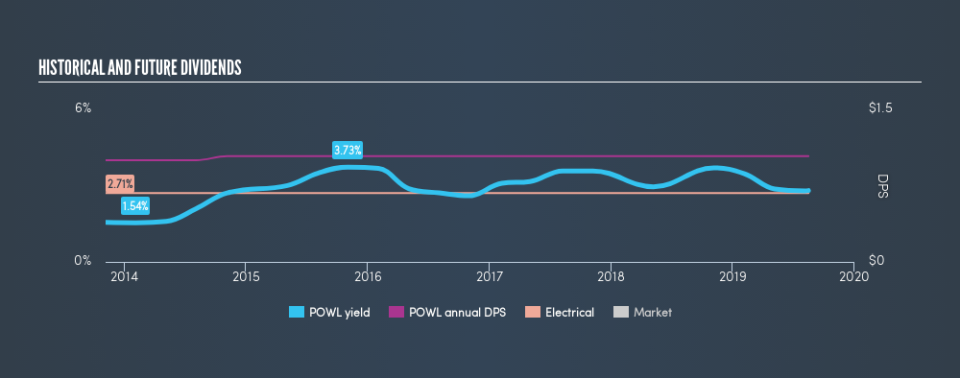Here's Why We're Wary Of Buying Powell Industries, Inc.'s (NASDAQ:POWL) For Its Upcoming Dividend

Powell Industries, Inc. (NASDAQ:POWL) is about to trade ex-dividend in the next 3 days. Investors can purchase shares before the 20th of August in order to be eligible for this dividend, which will be paid on the 18th of September.
Powell Industries's next dividend payment will be US$0.26 per share, and in the last 12 months, the company paid a total of US$1.04 per share. Based on the last year's worth of payments, Powell Industries stock has a trailing yield of around 2.8% on the current share price of $37.06. If you buy this business for its dividend, you should have an idea of whether Powell Industries's dividend is reliable and sustainable. That's why we should always check whether the dividend payments appear sustainable, and if the company is growing.
See our latest analysis for Powell Industries
Dividends are typically paid from company earnings. If a company pays more in dividends than it earned in profit, then the dividend could be unsustainable. An unusually high payout ratio of 246% of its profit suggests something is happening other than the usual distribution of profits to shareholders. Yet cash flow is typically more important than profit for assessing dividend sustainability, so we should always check if the company generated enough cash to afford its dividend. Fortunately, it paid out only 43% of its free cash flow in the past year.
It's good to see that while Powell Industries's dividends were not covered by profits, at least they are affordable from a cash perspective. Still, if the company repeatedly paid a dividend greater than its profits, we'd be concerned. Extraordinarily few companies are capable of persistently paying a dividend that is greater than their profits.
Click here to see the company's payout ratio, plus analyst estimates of its future dividends.
Have Earnings And Dividends Been Growing?
Companies with falling earnings are riskier for dividend shareholders. Investors love dividends, so if earnings fall and the dividend is reduced, expect a stock to be sold off heavily at the same time. Powell Industries's earnings per share have plummeted approximately 34% a year over the previous five years.
The main way most investors will assess a company's dividend prospects is by checking the historical rate of dividend growth. In the past 6 years, Powell Industries has increased its dividend at approximately 0.7% a year on average.
The Bottom Line
Is Powell Industries worth buying for its dividend? It's not a great combination to see a company with earnings in decline and paying out 246% of its profits, which could imply the dividend may be at risk of being cut in the future. However, the cash payout ratio was much lower - good news from a dividend perspective - which makes us wonder why there is such a mis-match between income and cashflow. It's not an attractive combination from a dividend perspective, and we're inclined to pass on this one for the time being.
Wondering what the future holds for Powell Industries? See what the three analysts we track are forecasting, with this visualisation of its historical and future estimated earnings and cash flow
A common investment mistake is buying the first interesting stock you see. Here you can find a list of promising dividend stocks with a greater than 2% yield and an upcoming dividend.
We aim to bring you long-term focused research analysis driven by fundamental data. Note that our analysis may not factor in the latest price-sensitive company announcements or qualitative material.
If you spot an error that warrants correction, please contact the editor at editorial-team@simplywallst.com. This article by Simply Wall St is general in nature. It does not constitute a recommendation to buy or sell any stock, and does not take account of your objectives, or your financial situation. Simply Wall St has no position in the stocks mentioned. Thank you for reading.

